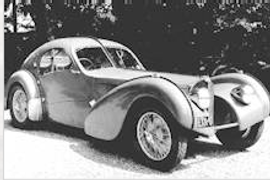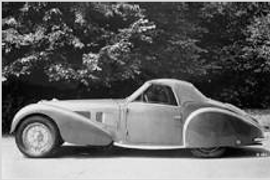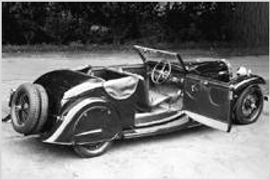BUGATTI Type 57 Models/Series Timeline, Specifications & Photos
First production year: 1934
Engines: Gasoline
Body style: Coupé (two-door)
The Bugatti Type 57 SC Atlantic was one of the most iconic Bugatti cars ever made. It was one of the most exclusive and expensive cars ever made. Only four were built and only three still exist.
While Europe fog of war started to rise from Hitler's Germany, in France Ettore Bugatti gave the green light for producing the Type 57 SC. The design was based on Ettore's son, Jean Bugatti's concept-car Aerolithe. There were two versions for the 57 SC: the Atlantic and the Atalante. The Atlantic Coupe is considered “The Holy Graal” of the Bugatti cars. Only four of these were manufactured between 1936 and 1938. The automotive world has been searching for the fourth Atlantic ever since. Jean Bugatti died in 1939, at the age of 30, in a car crash when he tried to avoid a drunken cyclist, but his legacy lived on with the Type 57 SC Atlantic. The “S” letter came from “surbaisse” (lowered) and the “C” came from the Compresseour (Supercharger).
The design was like a teardrop with a long nose and a sloped rear. Under the curved, flat, end, there was the spare-wheel compartment. The car featured a fin across the roof and back, down to the six stainless steel exhausts. The magnesium fine-wire wheels were kept in place by a single log nut. The bodywork was built entirely from a light, but flammable, magnesium alloy named Elektron.
Inside, there were two seats and a shelf behind them, for luggage. The four-spoke, big, steering wheel resembled the Bugatti race-cars. A long gear-lever came from underneath the dashboard, angled toward the driver.
Under the hood, there was a 3.3-liter supercharged engine with 8 inline cylinders. It featured double overhead camshafts and a total output of 200 hp. When combined with a total weight of just 950 kg (2090 lbs), the result was mindblowing for those times.
Bugatti Type 57 was one of the most famous vehicles built by the famous French car-maker before WWII. It was introduced as an S-version and, later on, the manufacturer added a supercharger and renamed-it SC.
After winning races around the world, the Bugatti established itself as a car-manufacturer able to produce the finest cars built for speed and endurance. “Le Patron” from the Molsheim factory understood that a lower center of gravity improves the cornering speed. In 1934 Bugatti launched the 57S version, where the S came from the “Sourbaisse”, which means "lowered".
A curved chassis allowed the car to sit lower to the ground and allowed the coachbuilders to create sleeker bodyworks. The long hood, curved fenders, and small cabin made it a performance car that was hard to catch on those times. Some 57S were custom-built, but some had bodies from the Bugatti's Molsheim factory.
The interior was fitted with two seats moved far in the back, just a little bit in front of the rear axle. To do that, the steering column was long and the instrument panel was installed on the other side of the dash panel.
The engine featured a double overhead camshaft (DOHC) with three valves per cylinder (one intake and two exhaust) that offered 135 hp. It was mated to a 4-speed manual gearbox.
Maybe not as famous as its brother 57 SC Atlantic, the 57 S was the base model that led to the rarest Bugatti in the world, the SC version. But all the lines started in 1934 with the 57S version.
After winning races around the world, the Bugatti established itself as a car-manufacturer able to produce the finest cars built for speed and endurance. “Le Patron” from the Molsheim factory understood that a lower center of gravity improves the cornering speed. In 1934 Bugatti launched the 57S version, where the S came from the “Sourbaisse”, which means lowered.
A curved chassis allowed the car to sit lower to the ground and allowed the coachbuilders to create sleeker bodyworks. The long hood, curved fenders, and small cabin made it a performance car that was hard to catch on those times. Some 57S were custom-built, but some had bodies from the Bugatti's Molsheim factory.
The interior was fitted with two seats moved far in the back, just a little bit in front of the rear axle. To do that, the steering column was long and the instrument panel was installed on the other side of the dash panel.
The engine featured a double overhead camshaft (DOHC) with three valves per cylinder (one intake and two exhaust) that offered 135 hp. It was mated to a 4-speed manual gearbox.


